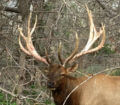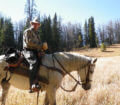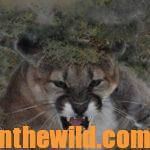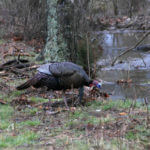Editor’s Note: Karl Badger from Salt Lake City, Utah, captures the essence of what elk hunting is all about and hunts elk all over the West. In some western states, mule deer and elk seasons start about August 15 for bowhunting and usually continue until the end of September. Firearms season continue to the end of November or the first of December.
 Most of my elk hunting is in wilderness areas. By hunting from horseback, I can get far back into some really-rough country where most other elk hunters won’t go. Many of the places I hunt also have restrictions for motorized vehicles, and you must travel on foot or horseback. When I go elk hunting, I want that extreme wilderness experience. Also, there is something mystical and romantic about riding a horse into really-wild country, carrying my bow or my rifle. Doing this takes me back to a time more than 150 years ago when no one but trappers, mountain men and Native Americans were in this part of the country hunting elk.
Most of my elk hunting is in wilderness areas. By hunting from horseback, I can get far back into some really-rough country where most other elk hunters won’t go. Many of the places I hunt also have restrictions for motorized vehicles, and you must travel on foot or horseback. When I go elk hunting, I want that extreme wilderness experience. Also, there is something mystical and romantic about riding a horse into really-wild country, carrying my bow or my rifle. Doing this takes me back to a time more than 150 years ago when no one but trappers, mountain men and Native Americans were in this part of the country hunting elk.
To get 25 or 30 miles into the back country, I take a pack string, including the horse I’m riding, two or three mules that carry most of my equipment and an extra horse. Then I can rest the horse I ride in on and hunt from the extra horse the following day. So, each horse gets a day of rest during the time I’m hunting. The mules will carry my entire camp, including a canvas tent, all my food, my personal gear and a cook stove for cooking my meals and for keeping my tent warm and dry, if the weather turns off bad.
 I’m often asked, “Why do you prefer to have mules in your pack string?” Mules are somewhat stouter than horses. Plus, most of my mules are bred for being pack animals, and my horses are bred for riding. Mules also have a very-nice gait, if you train them for riding. In my opinion, mules are better than horses when you have to go to a remote location and pack out an elk or a mule deer. I travel different distances, depending on the terrain. But on most hunts, I’ll travel 15 to 20 miles into the wilderness before I set-up my camp. I’ll usually spend 8 to 10 hours in the saddle riding to my camp site.
I’m often asked, “Why do you prefer to have mules in your pack string?” Mules are somewhat stouter than horses. Plus, most of my mules are bred for being pack animals, and my horses are bred for riding. Mules also have a very-nice gait, if you train them for riding. In my opinion, mules are better than horses when you have to go to a remote location and pack out an elk or a mule deer. I travel different distances, depending on the terrain. But on most hunts, I’ll travel 15 to 20 miles into the wilderness before I set-up my camp. I’ll usually spend 8 to 10 hours in the saddle riding to my camp site.
I hunt for two reasons. I like to be out in the wilderness by myself, going one-on-one with the elk, and I also like to be in camp and go on the hunt with friends and family. Some of the people I hunt with just like to stay at camp, wrangle the horses and help pack out the meat. I really enjoy sharing a hunt with my friends and family, whether I’ve got a tag, or I go along with them to help them try and take their elk. Besides hunting with several good friends, I really enjoy hunting with my son Travis.
 Another reason I prefer to pack in when I go elk hunting is because the elk is a really-large animal. After I field dress an elk, I’ve learned that putting all that meat, head and antlers on the backs of mules is much easier than carrying the meat, the head and the antlers out on my back. I’ve carried an elk out of the wilderness both ways – on my back and on the backs of my mules. The hunt is much more fun when the mules do the meat carrying. I do a lot of extreme backpack hunting for elk and wilderness hunting for elk in my home state of Utah.
Another reason I prefer to pack in when I go elk hunting is because the elk is a really-large animal. After I field dress an elk, I’ve learned that putting all that meat, head and antlers on the backs of mules is much easier than carrying the meat, the head and the antlers out on my back. I’ve carried an elk out of the wilderness both ways – on my back and on the backs of my mules. The hunt is much more fun when the mules do the meat carrying. I do a lot of extreme backpack hunting for elk and wilderness hunting for elk in my home state of Utah.
To get John and Denise Phillips’ free cookbook, “Miz Denise’s Outdoor Cooking: More than 35 Recipes for Elk and Mule Deer,” go to https://johninthewild.com/free-books. You also can learn about John’s other available elk books at https://johninthewild.com/books.










